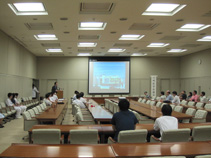Menu
- トップぺージ
- 講演会予定
- 過去の講演会
├令和6年
├令和5年
├令和4年
├令和3年
├令和2年
├平成31年
├平成30年
├平成29年
├平成28年
・第378回
・第377回
・第376回
・第375回
・第374回
・第373回
・受賞講演会
・第371回
・第370回
・第369回
・第368回
・第367回
・第366回
・第365回
・第364回
・第363回
・第362回
・第361回
・第360回
・第359回
・第358回
・第357回
・第356回
・第355回
├平成27年
├平成26年
├平成25年
├平成24年
├平成23年
├平成22年
├平成21年
└平成20年
- オンデマンド講演会
過去の講演会
第365回川崎医学会講演会
| :: 日 時 | 平成28年6月22日(水)17:30・18:30 |
| :: 場 所 | 別館6階大会議室 |
| :: 座 長 | 柏原 直樹 |
「New mechanism of endogenous nephron repair」
Janos Peti-Peterdi, MD, PhD
Departments of Physiology & Biophysics, and Medicine,
Keck School of Medicine, University of Southern California
Currently there is no cure for chronic kidney disease (CKD) other than non-specific drugs that only slow down progression. The unmet medical need and inadequacy of current treatments have led to great interest in regenerative stem cell approaches. In order to study the intra-renal localization, migration pattern and dynamics, and fate of resident mesenchymal stem/progenitor cells, we have developed serial intravital multiphoton microscopy (MPM) which allows for the high power imaging of glomerular remodeling and repair processes of the same glomerulus in the intact living mouse kidney over several days-weeks. The combination of serial MPM imaging with classic genetic cell fate mapping tools that use inducible fluorescent tags for the identification of a single adult kidney cell (for example using the multi-color Confetti reporter) or cell lineage provides important visual clues regarding cellular remodeling of kidney tissue in different conditions and kidney disease models in vivo. The use of this technology revealed the highly dynamic nature of glomerular environment and cellular remodeling. In NG2-Tomato mice, serial MPM imaging observed mesenchymal progenitor cells homing to the glomerular vascular pole and mesangial area and entering and remodeling the glomerulus and tubular segments in response to low salt diet+captopril treatment. In Ren-Confetti mice, cells of the renin lineage were seen entering the glomerulus through the Bowman’s capsule, and becoming PECs, podocytes, and proximal tubule cells. Using Cdh5-Confetti mice, serial MPM imaging observed the rapid remodeling of the glomerular endothelium that was triggered by glomerular injury, indicated by the development of monochromatic (single cell-derived) endothelial cell layer in glomerular capillary loops and in entire glomeruli within 4 days. The proliferation and migration of NG2+ cells were inhibited by the pharmacological blockade of macula densa (MD) cell enzymes COX-2 and NOS1, suggesting the major regulatory role of MD cells in the homing of renal progenitor cells into the glomerulus. The molecular fingerprint of MD cells established from RNA sequencing of freshly isolated MD cells from whole mouse kidneys indicated high level of expression of new angiogenic, matrix remodeling, patterning, cell growth and differentiation genes. In summary, our results suggest the dynamic cellular remodeling of the renal interstitium, vasculature, glomerulus, and the proximal tubule by renal progenitor cells, and the regulation of this nephron remodeling program by the cells of the MD. The more precise mechanistic understanding of this novel nephron repair program needs further study.

